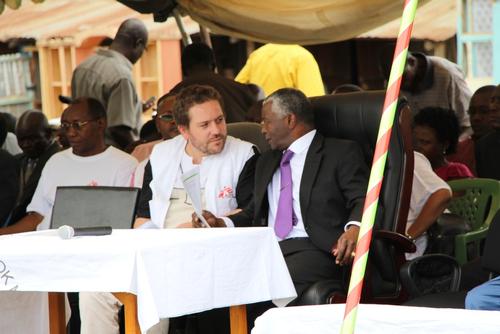Homa Bay hospital in the late 1990s was a scene of despondency, its wards crowded with people ravaged by AIDS. “There was virtually no space in the medical wards, even beside or under the beds,” remembers Médecins Sans Frontières (MSF), then head of mission. “Each space was occupied by a skinny and obviously terminally ill AIDS patient or their caretaker. Overwhelmed and demoralized staffs were encouraging families to take their loved ones home to die.”
When MSF began working in Homa Bay in 1996, this remote, rural area was gripped by a growing dual epidemic of AIDS and TB. Yet apart from the terminally ill patients blocking the aisles of the hospitals, there was no clear picture of the extent of the epidemic. At that time, treatment for HIV/AIDS was unavailable, and the few testing facilities which existed charged people Ksh 500 for an HIV test.
MSF started by setting up a range of services, all of them free-of-charge. These included testing people for the disease; care for other sexually transmitted diseases; care for other infections related to patients’ weakened immune systems; and prevention. But we were faced with a seemingly insurmountable problem: the lack of affordable drugs to treat AIDS patients, which at that time cost US10,000-15,000 per patient per year.
Around the same time, MSF launched its Campaign for Access to Essential Medicines, whose first success was bringing down the price of antiretroviral (ARV) drugs used to treat HIV/AIDS. As a result, in 2001 Homa Bay District hospital became the first public hospital in Kenya to provide ARV drugs for free. At the same time as saving people’s lives, we aimed to demonstrate that it was feasible to treat patients in rural contexts where resources were limited, and we hoped to provide impetus for others to start doing the same elsewhere.
When I arrived in Homa Bay in 2003, we were still learning how best to care for people infected with the virus, and were struggling to cope with more sick patients than we had capacity for. Being the only provider of HIV treatment in the region for some time, the team had no choice but to limit the number of patients being started on ARV drugs, with priority going to the very sick. Later that year, we decided to scale up our activities and enrol more patients, at the same time as decentralising care to other health facilities in the area.
I left Kenya in 2005, but when I returned in 2012, I was impressed to see the progress made by the government and its partners in making diagnosis and treatment accessible to many more patients. Today, 70 percent of people in need of treatment are getting it, according to the Kenyan AIDS Information Survey 2012.
But despite all the energy and resources directed at scaling up people’s access to diagnosis, treatment and prevention in recent years, the HIV epidemic continues to spread at an alarming rate in some parts of Kenya – a fact confirmed by our 2012 Ndhiwa HIV Population Survey (NHIPS). There is clearly still much to learn about how to significantly decrease the number of people becoming infected, especially in areas with a high burden of HIV.
This is why MSF has decided to change its approach. We have started handing over the running of the Homa Bay HIV clinic to the government – to be completed by December 2015 – while at the same time initiating a pilot program which will attempt to curb the epidemic in Ndhiwa sub-county over a four-year period. If this is successful, the program could be adapted to other parts of the country where the epidemic is still raging.
The first step in decreasing the spread of HIV is to make sure that people with the virus are diagnosed. This calls for regular testing – at least once a year in some contexts, and even more often for certain at-risk groups.
The next step is to put people on treatment at an earlier stage – before their immune systems have become suppressed, and precisely while their viral load (the quantity of the virus in their blood) is high – which will mean changing the current protocols. As more people start ARV treatment, we will need to monitor their viral loads to ensure that their risk of transmitting the disease to others is as small as possible.
At the same time, other methods of preventing people from becoming infected need to be explored or scaled up. This includes improving efforts to stop HIV-positive mothers transmitting the disease to their babies during pregnancy or childbirth.
Meanwhile, mortality rates remain high among sick patients receiving hospital treatment. Improvements need to be made to the care they receive – an area which currently receives little funding or attention.
So much has changed in the two decades since MSF first came to Homa Bay. With all the progress made so far, and with new scientific evidence and medical tools providing hope that the epidemic can finally be brought under control, there needs to be a sustained effort and a scale up of investment to make this hope a reality. It will be a challenge – especially in badly affected areas such as Ndhiwa – but we believe that HIV can and must be beaten.
MSF is an international, independent, medical humanitarian organization that delivers emergency aid to people affected by armed conflict, epidemics, natural disasters and exclusion from healthcare. MSF has been continuously working in Kenya since 1987. We were the first organisation to provide free antiretroviral therapy in public health facilities in Kenya, in what is now Homa Bay County. We specialise in emergency medical response, especially when others cannot intervene or are overstretched and offer assistance based on need and irrespective of race, religion, gender or political affiliation.



